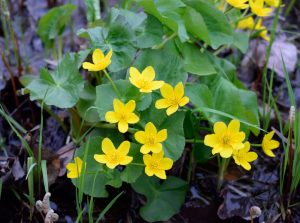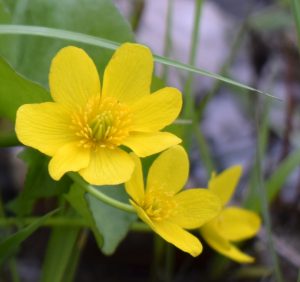Marsh Marigold


Caltha palustris, also known as cowslip, fills roadside ditches and other areas where shallow water occurs with splashes of luscious, bright yellow blooms April and May. This yellow beauty is a yearly awaited favorite for many and a sure sign of spring.
Marsh marigold displays an interesting characteristic in that it has no petals. What you are seeing greatly resembles 5 to 9 (usually 5) rounded petals, but they are actually the sepals of the plant smiling up at you with their distinct veins radiating from the base. Sepals are the leaf-like parts, usually green, that clasp the unopened flower buds. They make up part of the the structure called the calyx, usually located underneath the opened petals of a flower. Marsh marigold’s sepals, however, are yellow — just to keep us guessing! And they are just as effective in every way including acting as cups to hold nectar and pollen attracting several species of bees.
Marsh marigold is not a marigold at all. With its bright yellow flowers, one can easily see why it belongs to the buttercup family, many of which show this characteristic of having various combinations of petals and/or sepals, or no petals at all! Leaves are round to kidney-shaped with a deep cleft in the heart-shaped base. Enjoy looking, but do not eat marsh marigolds in their raw form, as they are toxic to humans, horses and cattle.
